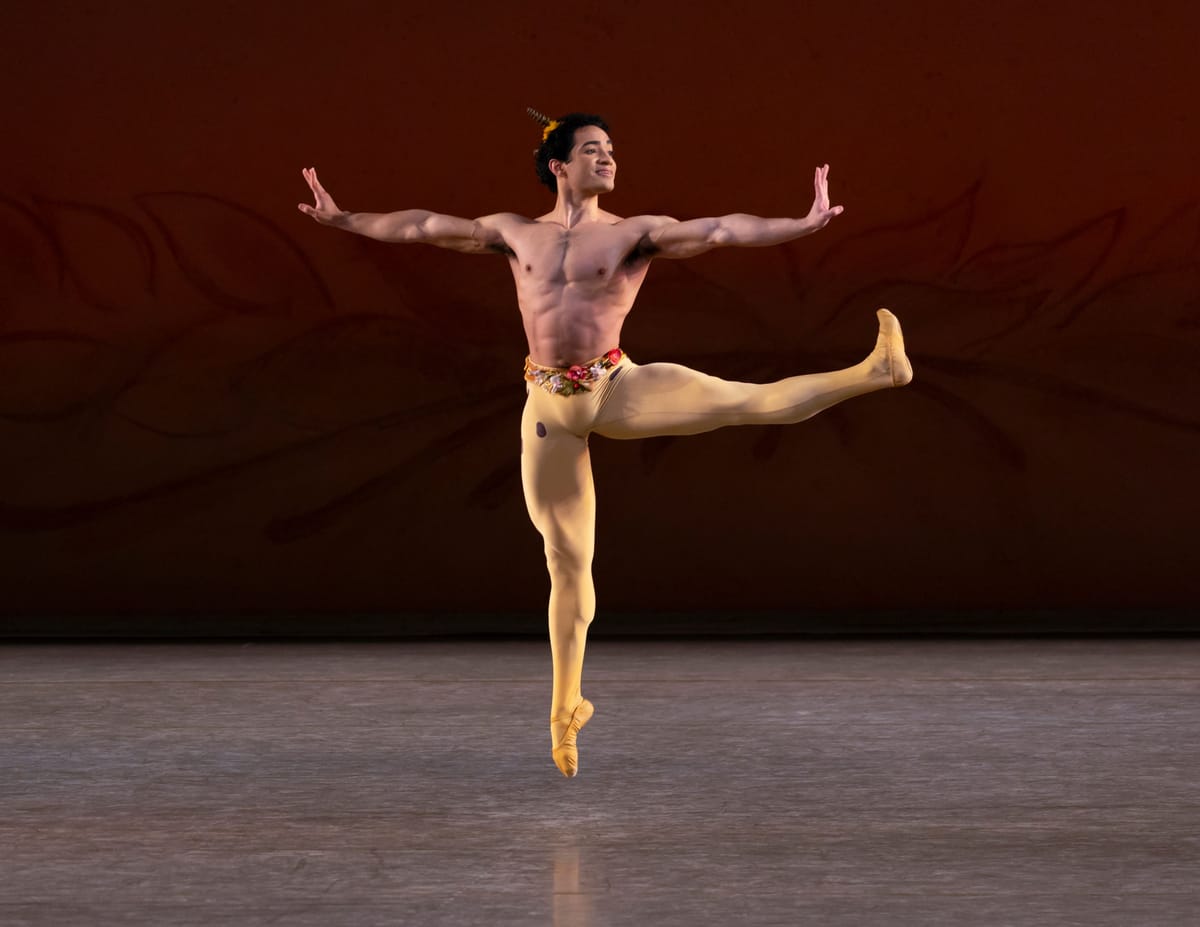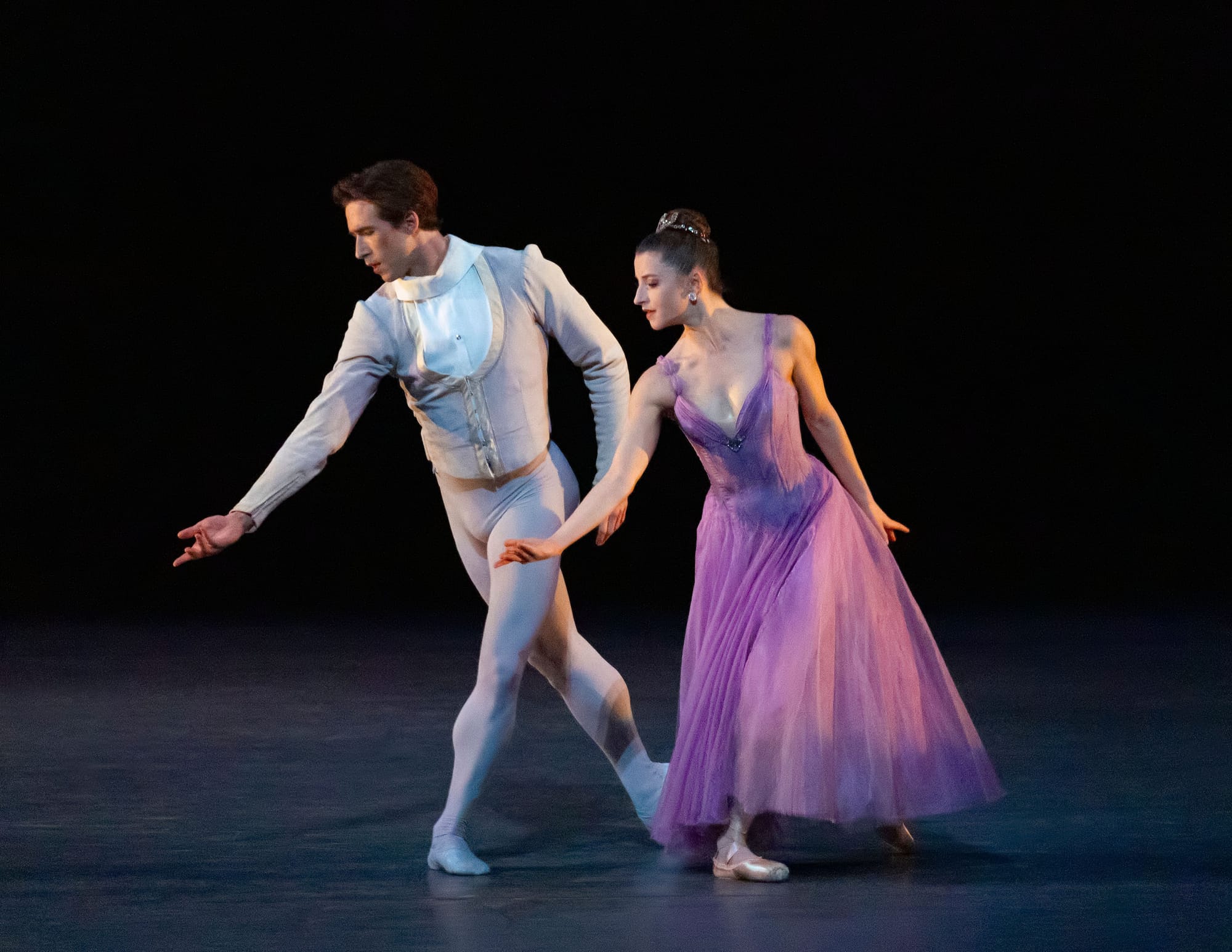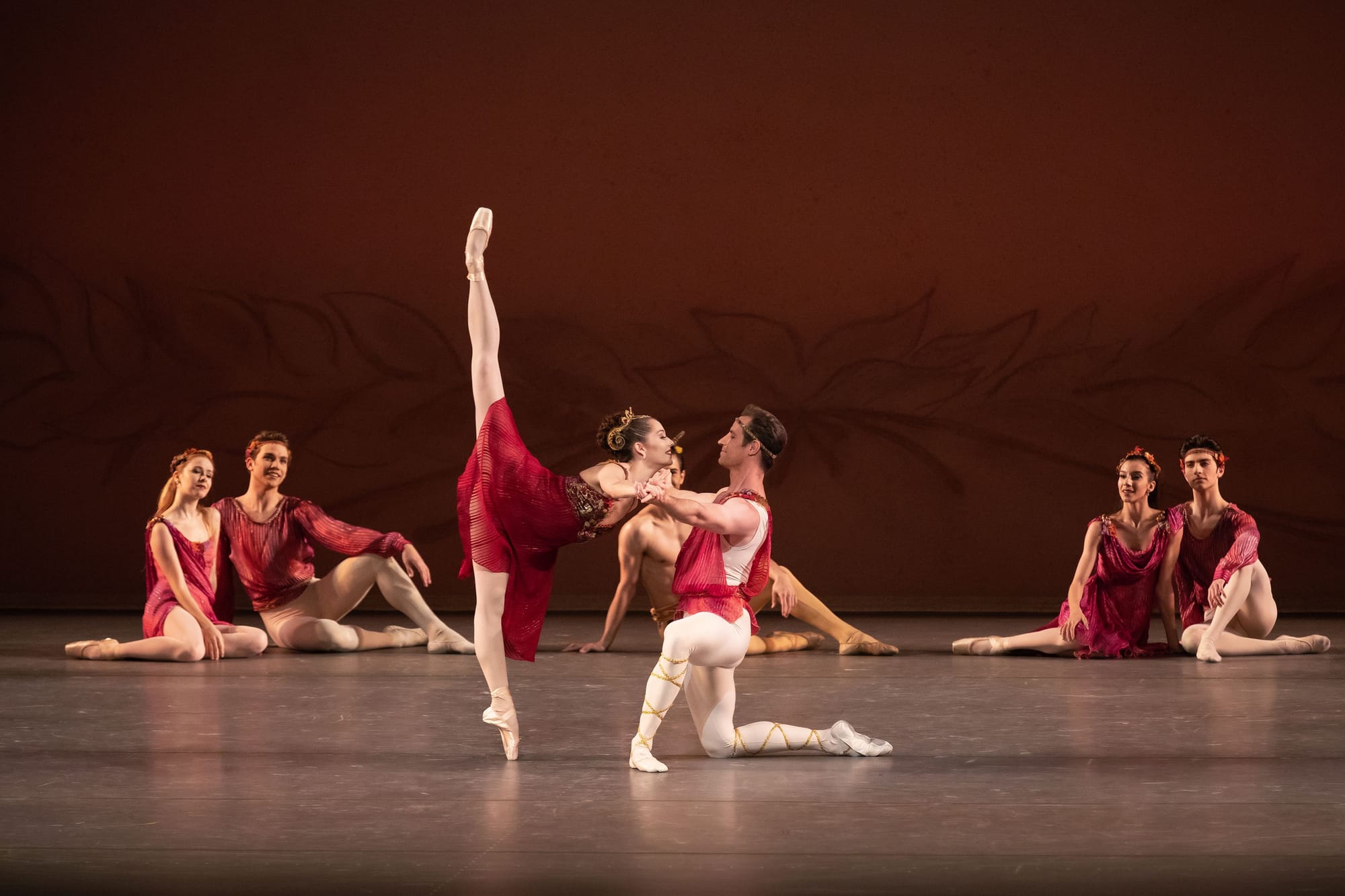Robbins x Three

"Fancy Free", "In the Night", "The Four Seasons"
New York City Ballet
David H. Koch Theater
Lincoln Center
New York, New York
January 24, 2024
The Winter season of NYCB’s 75th anniversary is titled “The Evolution” and includes works of a selection of choreographers whose works presumably evolved from Balanchine, who was so gloriously celebrated in the Fall. Three works by Jerome Robbins, who after Balanchine, is the choreographer most closely associated with NYCB, opened the Winter season; these created a fine, varied triple bill. "Fancy Free was the first ballet Robbins choreographed and was created for Ballet Theatre (now ABT) in 1944, and from its first cartwheel, it was a triumph. NYCB first danced it in 1980 and it’s character driven story has given any number of their male dancers a chance to show off their acting chops. “In the Night” is a more typical Robbins work, choreographed to Chopin nocturnes in 1970, just a year after his monumental “Dances at a Gathering”, and is full of difficult lifts and swooning backbends. “The Four Seasons”, set to selections of Verdi’s ballet music, is a glorious romp with Robbins looking back with an affectionate twinkle at the old fashioned Russian bravura.
Daniel Ulbricht, Harrison Coll, and Sebastian Villarini-Vélez danced the three sailors out on the town with a fine camaraderie; “Fancy Free” is a rare ballet celebrating friendship. Ulbricht has been dancing the smaller spitfire for a number of years but his strong, clear technique seems ageless, and he jumped into his splits as if he were 20 years younger. Coll was quietly appealing as the shy sailor, looking as if he were fresh off the farm, and his awkward (and obviously exaggerated) boast about destroying the whole Japanese air force had a touching desperation as he tried so hard to impress the girl. Villarini-Vélez was a more subdued Latin hot shot than some, which made his character more vulnerable, and his show-off rhumba had an underlying unease; he was a real character and not a cartoon.
Lauren Collett as the girl with the red pocket book was also a real character, sassy, confident, and flirtatious without vulgarity. She was willing to go along with the joke, knowing, as a real 1940’s gal, that she could stop it at any time. In recent years, there has been some criticism of the pocketbook incident--potential rape and assault are some of the terms thrown around, but the 1944 audience (and the fictional girls in the ballet) would have had brothers, sons, and boyfriends in uniform and would have understood the sailors' relief and joy at landing in New York. Art isn't only a mirror that only reflects current attitudes, it is also a window to to the past. In her debut as pas de deux girl Jacqueline Bologna was a bit less of a vivid character than Collett; she was dancing a generic love story, all swoops and ecstatic backbends, rather than a New York working girl who is rather amused but still touched by the naive bragging of the lonely sailor.

The three pas de deux of “In the Night” are full-throated love stories of three different couples in elegant costumes against a dark sky. Indiana Woodward and Joseph Gordon danced the first couple, a portrait of youthful passion. Though the choreography is a bit repetitive (lots of running and backbends) Woodward and Gordon gave an ecstatic and gripping performance, locked into each other’s eyes and seeming to float with joy. Woodward’s serene and elegant upper body and Gordon’s noble restraint gave their dancing a hint of the nineteenth century, echoing the Chopin music.
The second pas de deux shifted to a ballroom, based at least on the abstract chandeliers outlined by the lights, though it was a very dark room. Emilie Gerrity, in her debut, and Tyler Angle danced the somewhat older, formal, and dignified couple who seemed to be dancing in a Polish court (there was a folkish tinge to some of their arm movements). Their demeanor was cool, as they barely looked at one another though they did pause for an upside down lift which seemed completely out of place, but Robbins did like his applause-generating moments. These moments were impressively performed, especially since Angle was substituting for Aaron Sanz and so may have had little rehearsal time. Gerrity’s dancing was stately and smooth; a fine debut. There is nothing stately or smooth about the third dance, a fraught “can’t live with him/her, can’t live without him/her” tussle (lots of running back and forth between clutches), danced with a fierce conviction by Tiler Peck and Gilbert Bolden III. The moment when she prostrated herself before him was wrenchingly personal.
There is nothing personal about “The Four Seasons”, an homage/send up of the gloriously overstuffed final acts of nineteenth century ballets, set to imminently danceable excerpts of ballet music from Verdi operas. Winter featured Erica Pereira supported with elegant verve by David Gabriel (a debut) and Andres Zuniga. She skated through the bouncy steps, avoiding the “I’m so cute” trap.
Spring warmed everything up with debuts by Olivia MacKinnon and Jovani Furlan. Furlan was outstanding, smooth and elegant with immaculately plush landings; he had a powerful, otherworldly air, as if he really was a magical creature able to make the grass grow and the flowers bloom. It was a performance that projected far beyond the stage. MacKinnon danced clearly (her turns were especially secure) and looked confident and relaxed but as yet portrayed a dancer doing steps, not the embodiment of nature’s rebirth. The four men (Christopher Grant, Spartak Hoxha, Alec Knight, and Davide Riccardo) hopped elegantly and precisely through their dance, as if the men in “Raymonda’s” pas de quatre had turned in to the most elegant of frogs.

Ashley Laracey, with Adrian Danchig-Waring, was a slinky, languorous Summer, with flowing arms just short of hootchie coochie in Robbins’ Oriental fantasy. Fall is a fantasy too, a full-blooded Bolshoi bacchanal. Cainan Weber had a spectacular debut as the Puck figure, dancing with an electric but easy power—his joints seemed to be well-oiled. He even made the inevitable somersault look elegant. The power couple, Unity Phelan and Andrew Veyette, though, missed some of the tongue in cheek sparkle the over the top bravura needs. Phelan, looking astoundingly lovely in her costume, was cool and elegant, with large but light jumps, but she didn’t reach out and grab the audience. Though his turns a la seconde were impressively fast, Veyette had some trouble with landing his jumps, and seemed to get by on grit. The whirl of color at the end, when all the seasons came out the honor Verdi, though, sent everyone home happy.
© 2024 Mary Cargill



